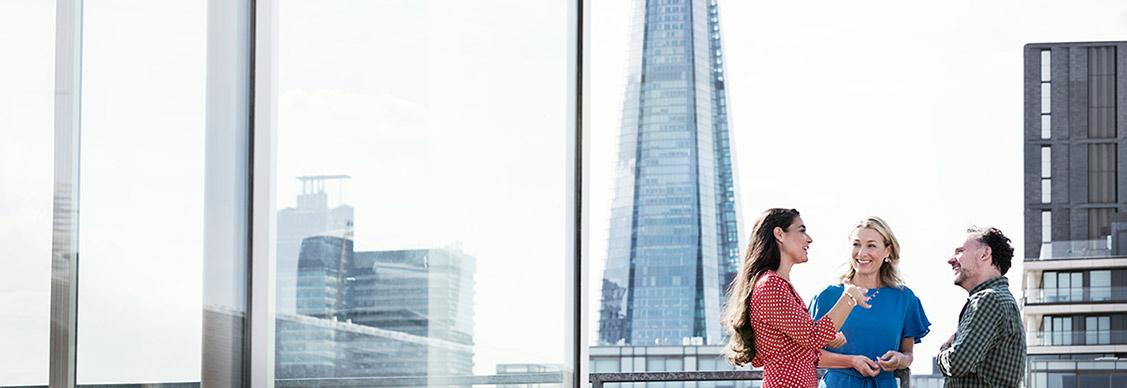How landlords are making their rooftops work harder
Demand for rooftop space is growing as new uses come to the fore
Landlords are increasingly looking to rooftops to deliver financial and environmental benefits, as well as adding more social value for their tenants and the wider community.
Across a wide range of commercial real estate, vacant roof space is finding new uses, from hosting drone delivery pads to accommodating solar panels or being transformed into landscaped gardens or events areas.
“More investors are looking to the potential offered by the top of their buildings,” says Vince Shiels, Director, Managed Services at JLL. “But the options vary greatly – and are determined by a host of external factors, from location to light, to safety and planning permission.”
Retail real estate investment trust, Vicinity Centres and Google-owner Alphabet’s subsidiary, Wing, launched the world’s first rooftop drone delivery service in Australia last year. Drones are sent out from shopping center rooftops to deliver on-the-go food and drinks to customer homes, with plans to add pharmaceuticals, beauty, and personal care products.
“There’s huge potential for drone deliveries both from and to building rooftops – but take-up will vary depending on local restrictions and rulings regarding low-flying apparatus, especially in built-up, highly-populated areas,” says Andrew Child, Director, Managed Services at JLL in London.
“And cities that were planned on a grid system may prove to be easier for drones to successfully navigate through.”
While some city office buildings already boast helipads for their high-flying executives, the arrival of airborne taxis could intensify the scramble for roof space. In Italy, a flying taxi service from Rome airport to the center of town is now up-and-running.
Globally, some 20 airborne vehicles are either in development or production, according to research by the Massachusetts Institute of Technology.
“Such services may be many years off in terms of becoming commonplace in cities, but they will need convenient places to land in urban areas – particularly in areas of high density where ground level options are limited,” says Child. “That could point to rooftops.”
Looking for more insights? Never miss an update.
The latest news, insights and opportunities from global commercial real estate markets straight to your inbox.
Keeping overheads down
With greater focus on clean energy, landlords are exploring onsite renewable energy opportunities. British Land and Hammerson have installed solar panels on shopping centers while IKEA owner Ingka has added some 935,000 solar panels to warehouse and store roofs in recent years.
“Energy costs are rising, so it’s a strategy that makes sense to keep overheads down while helping companies to hit their sustainability goals,” says Shiels. “Due to their larger size, warehouses and shopping centers are a better choice for solar as they host and generate higher levels of renewable energy than smaller office or residential tower rooftops.”
Finding rooftop space may, however, prove to be a challenge. An increased focus on maintaining healthy buildings through good quality air and regular airflow means rooftop space is often needed for air conditioning units.
“Rooftop space is at a premium, particularly in large, high-density cities,” says Child. “Finding the space to accommodate both the growing need for ventilation systems and outdoor gardens or events areas can be a challenge.”
Creating spaces for people
The competing needs for rooftop space are inspiring different approaches to building design. In the UK, the Fitwel 2-star rated 60 London Wall office building offers outdoor space to its tenants through a series of tiered terraces in a wedding cake design on its upper five floors.
“There’s increased onus among companies to create workplaces which support the physical and mental health of their employees,” says Child. “Looking at design options beyond the simple flat roof approach mean a greater number of tenants can benefit from their own accessible clean and open spaces.”
The key is using the space to provide amenities that optimize the employee experience. The White Collar Factory coworking development in London, for example, has transformed its rooftop into a terrace for outdoor lunches and meetings – along with a 150-meter running track circling the edge. Google’s new London HQ boasts 300 meters of landscaped rooftop gardens and a 200 meter running track.
For now, many rooftops are still undeveloped but as demand grows for outdoor urban space, many will look different in the years to come.
“Buildings – and landlords - have to adapt to the changing world around and the evolving expectations of tenants,” says Shiels. “Rooftops that rise to the challenge will give buildings an edge – both in terms of their financial performance and their sustainability and wellbeing credentials.”
